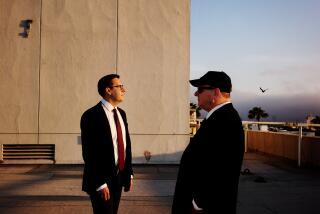How ‘Hitchhiker’s’ got picked up
- Share via
London — Fans of Douglas Adams, the British writer who created the beloved science fiction comedy “The Hitchhiker’s Guide to the Galaxy,” were stunned by his sudden death from a heart attack, at age 49, in a Santa Barbara gym four years ago.
There was an extra dimension to the sadness surrounding the author’s demise. Two years earlier, he had moved from his north London home to California, having signed a deal with Disney to create a feature film of “The Hitchhiker’s Guide.” It had been a long time coming; the radio series was first broadcast in Britain in 1978, and the “Guide” empire included books and a TV sitcom. But at the time of his death, Adams was still struggling to create a workable script.
“Douglas always wanted there to be a movie,” observes Robbie Stamp, Adams’ friend and business partner. “He believed a movie should be taking its place in the canon of his works.” Finally, it has happened, but only after plenty of hectic behind-the-scenes maneuvering, with new principals replacing old. Yet there has been a constant determination to keep the film true to the irreverent spirit in which Adams created the story.
“We’ve worked hard to make sure [the film is] true to itself,” observes Stamp, who is now its executive producer. “It’s a strange, unique thing. I’ve always loved the fact that you can’t ever describe it as a cross between one movie and another.”
There’s a sound commercial logic in this approach. “The Hitchhiker’s Guide to the Galaxy” has become a modern classic, translated into 25 languages. It has sold more than 2 million copies in Britain alone and, according to a spokeswoman for Adams’ London-based literary agent, Ed Victor, “16 million copies worldwide thus far.”
Its hero is a diffident Englishman, Arthur Dent, who becomes the last surviving man on Earth after the planet is destroyed. He finds himself traveling around space (dressed in a robe and pajamas and clutching a towel) with his best friend, Ford Prefect (who turns out to be an alien), Zaphod Beeblebrox (president of the galaxy) and Trillian, a young woman Arthur met at a fancy-dress party, his last on Earth. “The Hitchhiker’s Guide” has a philosophical bent, but its wit is light and brilliant; Adams’ humor is self-deprecating and distinctly British.
After his premature death threw film plans into disarray, Disney asked writer Karey Kirkpatrick (who took the screenplay credit on “Chicken Run,” another film comedy with a heavily British accent) to work from Adams’ last revisions to his story and turn them into a coherent narrative.
Yet before long, the word leaking out about the proposed film was causing alarm bells to ring on websites for fans of “The Hitchhiker’s Guide to the Galaxy” (they call it H2G2). Their big fear was that Adams’ quintessentially English creation would be crudely Americanized.
The Hollywood factor
On the face of it, there was cause to worry. Disney is, after all, a Hollywood studio. And three American actors had been cast in crucial roles: Sam Rockwell as Beeblebrox, Zooey Deschanel as Trillian (a minor character in Adams’ book, but now given a screwball-comedy romance with Arthur); and, most surprisingly, hip-hop artist Mos Def as Ford Prefect. British H2G2 fans, not wanting the film to resemble a by-the-numbers, Hollywood-style, CGI-heavy action movie, were dismayed.
Curiously, Deschanel was among those who sympathized with their concerns. “I read the book when I was 12,” she said, speaking by phone from Los Angeles, “and I think it’s wonderful -- so funny and unique. It’s very British in its humor, but that’s better than being very American -- at least I think so. I tend to like British humor.”
Yet the Americans acquit themselves well, particularly Rockwell, who portrays Beeblebrox as a titanically stupid rock god with Freddie Mercury mannerisms. The story’s British origins remain intact, thanks to Martin Freeman (Tim from the Emmy-winning BBC-TV comedy “The Office) as Arthur; the unseen Stephen Fry, who wryly narrates the story in his veddy British tones; and Bill Nighy as the planet designer Slartibartfast (fiords a specialty).
Most of the book’s best lines and situations survive. Its catchphrase “Don’t panic!” is liberally sprinkled around, “42” is still the answer to the ultimate question, Arthur still can’t ever quite get the hang of Thursdays -- and a towel, a manic-depressive android and a whale falling from the sky all make important appearances. Above all, the sense of wonder and joy that Adams instilled in his creation have transferred successfully.
This last achievement can be credited to two men working from a barge named Poppy, moored on a canal in an unfashionable part of north London. Garth Jennings, 32, and Nick Goldsmith, 34, are a two-man collective known as Hammer & Tongs, who created stylish music videos for such artists as REM, Pulp, Blur and Beck. Neither had worked on a feature film before, but after an odd set of circumstances, Jennings became the director of H2G2, and Goldsmith its producer.
“At the time Douglas died, Jay Roach [director of the Austin Powers movies] was set to direct, but he stepped down and became a producer,” says the boyishly enthusiastic Jennings. “He suggested Spike Jonze, who didn’t want to direct but suggested us. We knew him a little. We all worked in videos, and he’d been down to visit us on the barge for a cup of tea.”
When their American agent mentioned the H2G2 script, “our attitude was ‘Don’t bother sending it,’ ” Goldsmith recalls. “It was coming from Hollywood, and we felt, ‘Chances are they’ve ruined it. We’d rather not read it; it’ll be depressing.’ But he sent it, and it sat around the barge for two weeks.”
Finally Goldsmith picked it up and found it surprisingly good. Then Jennings read it and agreed. “Now we had to think: This is our first film, there are huge expectations, this is a story people love and treasure,” reflects Goldsmith. “So did we want to set ourselves up for a fall? But it was perfect. There was so much for us to get our teeth into.”
He and Jennings decided to make a film true to Adams’ intentions -- funny, silly, with heart and spirit. Neither man felt hidebound by the author’s legacy: “Douglas used to say each incarnation of the story is its own thing,” notes Jennings. “So we didn’t have to try and make it look like the TV show. Our bible was the book.” Not that this stopped them from taking liberties they felt Adams might have liked: The film starts with a rousing show tune.
It might have been their first full-length movie, but once shooting began, Jennings and Goldsmith quickly won over their co-workers. “Not many people as cool as them are that friendly,” enthuses Freeman. “They come from an area of the industry -- music videos -- where it can be passe to be nice, but they’re delightful. There’s a certain awe and joy about them. Of course, for this story there had to be. It helped that we had two people at the helm who are basically children.”
An affectionate tribute
Given the story’s English origins, one would expect the film to be a British hit, but Deschanel thinks it also has a good chance in America: “I know a lot of people here who loved it too. People here are excited at the prospect of this film.”
A test screening in Pasadena confirmed this, says Jennings: “Word had got out that it was screening, and people were queuing around the block. There were fans in ‘Don’t Panic’ T-shirts. They screamed and yelled at the line ‘I could never get the hang of Thursdays’ and when the towel first appeared on the screen. It was a great reaction.”
“I think Douglas knew his script required work,” Freeman says. “Karey did something new. The script needed not to be a series of little Oxbridge sketches. It was ideas-led, but what it needed was a story.”
In fact the film is an affectionate tribute, and the recipient of that affection is never in doubt. It is dominated by the spirit of Douglas Adams, whose head even appears in one scene, in hologram form. And a somber dedication at its end reads simply: “For Douglas.”
“It’s not like some big, cold, CGI-dominated epic,” says Stamp, for whom the film’s release is the culmination of nine years’ work, five of them with Adams. “Garth and Nick have brought as much visual wit to it as Douglas had intellectual wit and intelligence. They were a perfect match.”
Standing alongside his barge, Goldsmith points west along the canal. “Douglas’ house is only about five minutes away,” he says. “It’s funny. He’d gone all the way to California to get this film made. And it ended up being made by two blokes from down the road.”
More to Read
Only good movies
Get the Indie Focus newsletter, Mark Olsen's weekly guide to the world of cinema.
You may occasionally receive promotional content from the Los Angeles Times.










